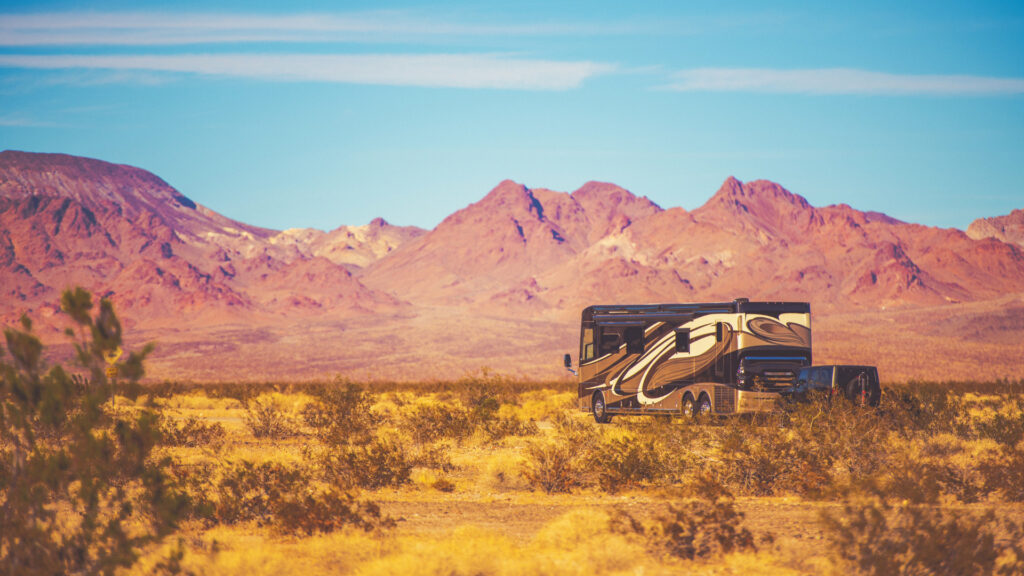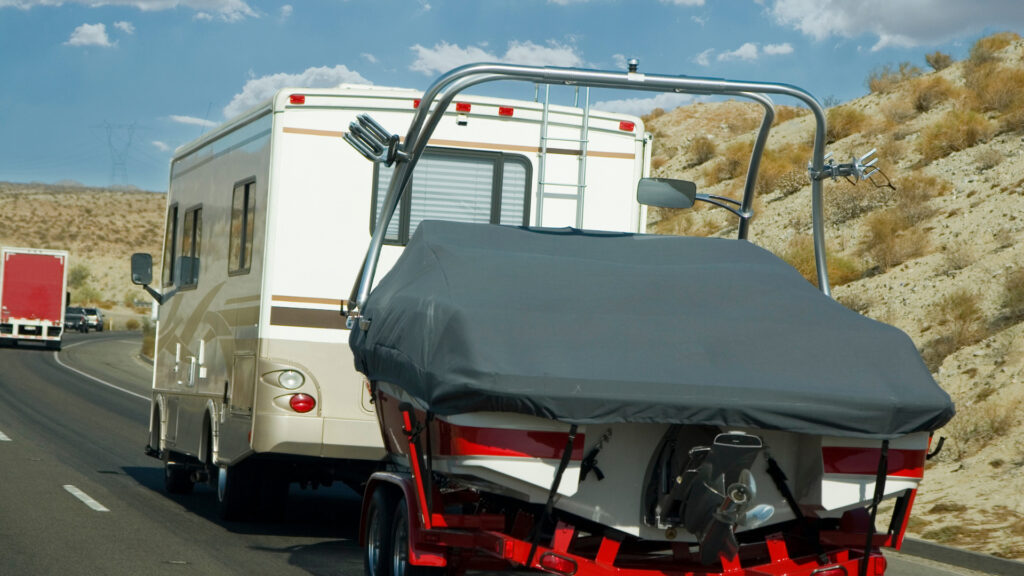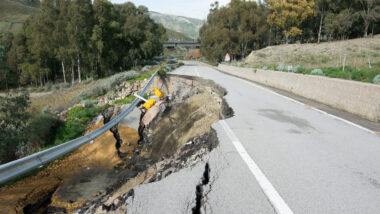Table of Contents Show
If you’re looking at motorhomes, you’ve probably thought about how you’ll get around once you’ve set up camp. Are you going to take your RV to the grocery store? Or will you be towing a second vehicle with a dolly? Many people choose the latter option because of the added convenience.
But then you have another choice to make. Which type of towing method is best? Is flat towing or towing with a dolly the better option for you?
Read on to learn more to help you make the best decision. It often comes down to personal preference and the vehicle’s capabilities. Let’s dive in!
What RVs Can Tow a Vehicle?
Motorhomes have hitches with the capability to tow a vehicle. Class As and Class Cs generally have tow ratings of 5,000 to 10,000 pounds depending on the RV.
It’s safe to attach a dolly to the back of a motorhome and tow a second vehicle as long as you stay within those tow limits set by the RV manufacturer.
Many towable RVs have hitches, which aren’t made for towing another vehicle. These can only usually carry bike racks or cargo trays. Towing a vehicle behind a travel trailer or fifth wheel is not recommended. Plus, triple towing is illegal in many states.
What Vehicles Can Be Towed Behind a Motorhome?
You can tow many types of cars behind a motorhome as long as the car and towing equipment remains under the RV’s maximum towing capacity and the hitch’s tow rating.
However, when towing with a dolly, you can’t haul a rear-wheel drive vehicle unless it has been modified. This is because the two rear wheels travel on the road while the front two wheels remain raised and secured on the dolly. So you’ll have to disconnect the driveshaft.
If you want to flat tow a vehicle, the list gets much shorter. Because they have to have the transmission disconnected and steering lockout override for flat towing, AWD and four-by-four cars are the preferred and more prevalent options.
You can’t flat tow just any vehicle. This is why many Jeep brand models are flat towed and not many Hondas.
Why Would an RVer Tow a Second Vehicle?
When traveling in a motorhome, getting around once you’ve set up camp can be hard. You can rent a car or use services like Uber, but few will likely pick you up from a remote campsite.
And many people prefer to have their own vehicle. They can run to the grocery store without packing their entire RV. They can head out to a national park without waiting for an Uber driver to pick them up. Having a second vehicle makes life more convenient.
What Is Towing With a Dolly?
Towing with a dolly requires a piece of equipment (the dolly) that attaches to the rear hitch of a motorhome. You then put the two front wheels of the vehicle on the dolly, and the two rear wheels travel on the road.
As mentioned earlier, this is why you can’t tow a rear-wheel drive vehicle unless you disconnect the driveshaft.
What Is Flat Towing?
Another method of towing is flat towing. The difference here is that all four wheels touch the road, spinning as you travel the highway.
Because this method requires the wheels to turn without turning the car on, you can severely damage your vehicle’s transmission if you tow a vehicle that isn’t AWD or four-by-four.
As mentioned earlier, you must have a transmission disconnect and steering lockout override to safely flat tow a vehicle.
Keep in Mind: Does Flat Towing a Car Add Miles to It? Let’s take a look!

What Are the Advantages of Towing With a Dolly?
Sometimes the choice is simple when deciding between towing with a dolly or flat towing. If you don’t have a vehicle you can flat tow, you must use a dolly.
Or sometimes you can raise all four wheels and tow with a trailer. Below are the advantages of towing with a dolly.
Can Tow Any Vehicle
Since you can only flat tow certain vehicles, a dolly opens up the options. You can haul practically any vehicle with a dolly. Unless you want to pay for expensive modifications to flat tow your vehicle, towing with a dolly may be your only option.
No Modifications Needed
You don’t have to do any modifications as long as your vehicle isn’t rear-wheel drive.
On the other hand, flat towing requires modifications. These changes also depend on the specific vehicle, so if you think you’ll flat tow two different cars — one during one camping trip and a different one another time — then you’ll have to modify both vehicles to flat tow.
Can Change Vehicles Easily
Because you don’t need serious modifications for dolly towing, you can take a Jeep Wrangler one weekend and a Toyota Camry the next.
The vehicles remain secured to the dolly and don’t require the baseplate kit, tow bar, cables, and other equipment needed for flat towing. Thus, you can easily switch out your car from one camping trip to the next.
Doesn’t Add Miles to Older Vehicles
Older vehicles without electronic odometers will tack on miles while being flat towed. If you have an older vehicle and don’t want to add miles to it, you can pull it with a dolly.
This also means less wear and tear on your car as only two wheels touch the road. This can cause less damage to your tires and axles.
What Are the Disadvantages of Towing With a Dolly?
However, even with the advantages, towing with a dolly may not work for everyone. You have some disadvantages you’ll want to consider before buying a tow dolly.
Have to Store Large Equipment
One of the biggest cons to towing with a dolly is finding a place to store the equipment.
Whether at a campground or at home, you have to put it somewhere. This can take up a lot of room in a small campsite or a garage. Plus, it can be bulky and difficult for some people to move.

Takes Longer to Set Up
Flat towing is easy to set up. Even one person can do it. However, this isn’t the case with dolly towing. It takes a bit longer to get the vehicle on the dolly and securely attached.
Although this shouldn’t deter you from towing with a dolly, it’s important to know before you start so you know to leave yourself plenty of time before you go.
Unable to Reverse
When towing a second vehicle behind a motorhome, you can’t reverse. This is true for both flat towing and towing with a dolly. You’ll potentially damage the vehicle and equipment.
So if you get into a bind and have to do a three-point road turn, it’ll be a mess. You’ll have to unhitch the vehicle, get the motorhome turned around, and then get everything set up again.
Keep in Mind: Could You Beat the World Record for Fastest Trailer Tow? Click the link to see what the record is!
Can Be More Expensive than Flat Towing
Depending on how much you spend on a tow dolly, this method can be more expensive than flat towing.
However, if you have to make modifications because you have a rear-wheel drive vehicle, that labor can also cost an arm and a leg. Disconnecting the driveshaft isn’t a DIY job, so you’ll want to let a mechanic handle this.
If you only make a couple of trips, you might want to rent a tow dolly for a few hundred bucks. A new one can cost anywhere from $3,000 to $4,000.
Which Is Better: Towing With a Dolly or Flat Towing?
There is no right or wrong method of towing. It’s what’s best for the vehicle and for you. You can tow any car but not always in the same manner. So always check your owner’s manual to ensure you follow the manufacturer’s recommendations for towing.
If you have a vehicle that you can flat tow, it’ll add wear and tear to the vehicle but be easier to maneuver and hook up. You also won’t have large equipment in the way at your campsite.
But if you choose to tow with a dolly, you won’t have to worry about modifications and can change out vehicles from trip to trip.
So which is better for you? Towing with a dolly or flat towing?







Did you forget about the auto carrier (all four wheels on the trailer)? We have always found this to be the best option for us.